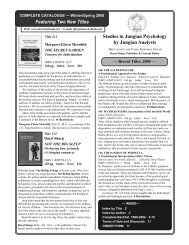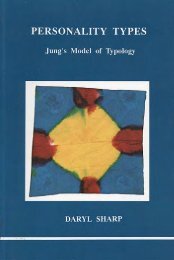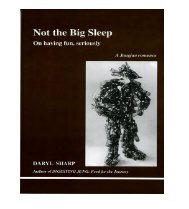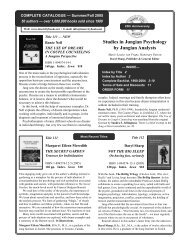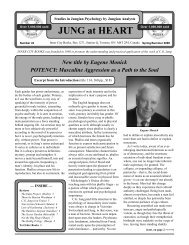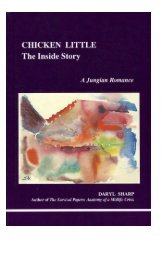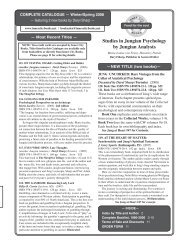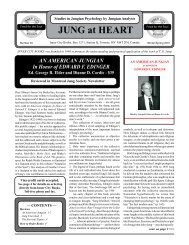Digesting Jung: Food for the Journey - Inner City Books
Digesting Jung: Food for the Journey - Inner City Books
Digesting Jung: Food for the Journey - Inner City Books
Create successful ePaper yourself
Turn your PDF publications into a flip-book with our unique Google optimized e-Paper software.
The Value of Conflict 39<br />
ing and feeling. If feeling is not a conscious factor in <strong>the</strong> conflict, it<br />
needs to be introduced; <strong>the</strong> same may be said <strong>for</strong> thinking.<br />
If <strong>the</strong> ego position coincides with, or can accept, <strong>the</strong> feeling attitude,<br />
all well and good. But if <strong>the</strong>se are not compatible and <strong>the</strong> ego<br />
refuses to give way, <strong>the</strong>n <strong>the</strong> situation remains at an impasse. That<br />
is <strong>the</strong> clinical picture of neurotic conflict, <strong>the</strong> resolution of which<br />
requires a dialogue with one’s o<strong>the</strong>r sides. We can learn a good deal<br />
about ourselves through relationships with o<strong>the</strong>rs, but <strong>the</strong> unconscious<br />
is a more objective mirror of who we really are.<br />
<strong>Jung</strong> believed that <strong>the</strong> potential resolution of a conflict is activated<br />
by holding <strong>the</strong> tension between <strong>the</strong> opposites. When every<br />
motive has an equally strong countermotive—that is, when <strong>the</strong> conflict<br />
between <strong>the</strong> ego and <strong>the</strong> unconscious is at its peak—<strong>the</strong>re is a<br />
damming up of vital energy. But life cannot tolerate a standstill. If<br />
<strong>the</strong> ego can hold <strong>the</strong> tension, something quite unexpected emerges,<br />
an irrational “third” that effectively resolves <strong>the</strong> situation.<br />
This irrational “third” is what <strong>Jung</strong> called <strong>the</strong> transcendent function,<br />
which typically manifests as a symbol. Here is how he described<br />
<strong>the</strong> process:<br />
[A conflict] requires a real solution and necessitates a third thing in<br />
which <strong>the</strong> opposites can unite. Here <strong>the</strong> logic of <strong>the</strong> intellect usually<br />
fails, <strong>for</strong> in a logical anti<strong>the</strong>sis <strong>the</strong>re is no third. The “solvent” can<br />
only be of an irrational nature. In nature <strong>the</strong> resolution of opposites<br />
is always an energic process: she acts symbolically in <strong>the</strong> truest<br />
sense of <strong>the</strong> word, doing something that expresses both sides, just as<br />
a waterfall visibly mediates between above and below. 21<br />
Outer circumstances may remain <strong>the</strong> same, but a change takes<br />
place in <strong>the</strong> individual. This generally appears as a new attitude<br />
toward oneself and o<strong>the</strong>rs; energy previously locked up in a state of<br />
indecision is released and once again it becomes possible to move<br />
<strong>for</strong>ward.<br />
At that point, it is as if you were to stand on a mountain top<br />
watching a raging storm below—<strong>the</strong> storm may go on, but you are<br />
21 “The Conjunction,” Mysterium Coniunctionis, CW 14, par. 705.



